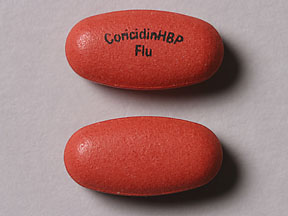Coricidin HBP Maximum Strength Flu Interactions
There are 545 drugs known to interact with Coricidin HBP Maximum Strength Flu (acetaminophen/chlorpheniramine/dextromethorphan), along with 7 disease interactions, and 2 alcohol/food interactions. Of the total drug interactions, 93 are major, 436 are moderate, and 16 are minor.
- View all 545 medications that may interact with Coricidin HBP Maximum Strength Flu
- View Coricidin HBP Maximum Strength Flu alcohol/food interactions (2)
- View Coricidin HBP Maximum Strength Flu disease interactions (7)
Most frequently checked interactions
View interaction reports for Coricidin HBP Maximum Strength Flu (acetaminophen / chlorpheniramine / dextromethorphan) and the medicines listed below.
- albuterol
- amlodipine
- amoxicillin
- aspirin
- atorvastatin
- Benadryl (diphenhydramine)
- benzonatate
- Claritin (loratadine)
- Coricidin HBP Cold & Flu (acetaminophen / chlorpheniramine)
- cyclobenzaprine
- doxycycline
- Flonase (fluticasone nasal)
- gabapentin
- hydrochlorothiazide
- ibuprofen
- levothyroxine
- lisinopril
- losartan
- melatonin
- meloxicam
- metformin
- Metoprolol Succinate ER (metoprolol)
- Mucinex (guaifenesin)
- omeprazole
- pantoprazole
- prednisone
- tramadol
- Tylenol (acetaminophen)
- Vitamin C (ascorbic acid)
- Vitamin D3 (cholecalciferol)
Coricidin HBP Maximum Strength Flu alcohol/food interactions
There are 2 alcohol/food interactions with Coricidin HBP Maximum Strength Flu (acetaminophen / chlorpheniramine / dextromethorphan).
Coricidin HBP Maximum Strength Flu disease interactions
There are 7 disease interactions with Coricidin HBP Maximum Strength Flu (acetaminophen / chlorpheniramine / dextromethorphan) which include:
More about Coricidin HBP Maximum Strength Flu (acetaminophen / chlorpheniramine / dextromethorphan)
- Coricidin HBP Maximum Strength Flu consumer information
- Compare alternatives
- Reviews (1)
- Drug images
- Side effects
- Dosage information
- During pregnancy
- Drug class: upper respiratory combinations
- En español
Related treatment guides
Drug Interaction Classification
| Highly clinically significant. Avoid combinations; the risk of the interaction outweighs the benefit. | |
| Moderately clinically significant. Usually avoid combinations; use it only under special circumstances. | |
| Minimally clinically significant. Minimize risk; assess risk and consider an alternative drug, take steps to circumvent the interaction risk and/or institute a monitoring plan. | |
| No interaction information available. |
See also:
Further information
Always consult your healthcare provider to ensure the information displayed on this page applies to your personal circumstances.


